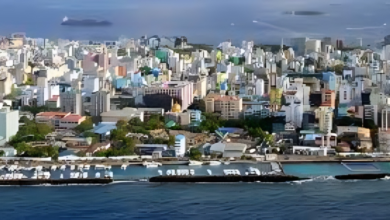
Understanding Surat’s Economy Key Drivers, Challenges, and Future Outlook
Surat, a prominent city located in the western part of India, is often regarded as the economic powerhouse of the state of Gujarat. Known for its vibrant textile industry, Surat’s economy has seen tremendous growth over the years, making it one of the fastest-growing cities in the country. This article will explore the key drivers of Surat’s economy, the challenges it faces, and the potential for future growth.
The Rise of Surat: A Historical Overview
Surat’s history as a thriving economic hub dates back several centuries. During the Mughal period, Surat was one of the most important ports for trade between India and Europe. Its strategic location on the banks of the Tapi River made it a key point for maritime trade, contributing significantly to the flourishing economy of the region. Traders from across the world, including the Portuguese, Dutch, and British, made Surat their base for trade, particularly in textiles, spices, and other goods.
Over time, Surat’s economy evolved, and despite facing challenges like natural disasters and political upheavals, the city continued to grow. In the post-independence era, Surat emerged as a textile and diamond hub, industries that would later become the cornerstones of its economy.
Key Drivers of Surat’s Economy
1. Textile Industry: The Heart of Surat’s Economy
The textile industry is undoubtedly the backbone of Surat’s economy. The city is one of the largest producers of textiles in India, contributing to the country’s reputation as a global leader in textile manufacturing. Surat specializes in synthetic fabrics, particularly polyester and silk, and has earned a reputation for producing high-quality materials.
A significant portion of Surat’s textile output is exported to countries around the world, including the United States, the United Kingdom, the Middle East, and various parts of Southeast Asia. The city is home to thousands of textile mills, ranging from small family-run businesses to large industrial units. Surat’s textile industry benefits from the presence of well-established supply chains, skilled labor, and modern infrastructure that enables the production of a wide variety of fabrics, including sarees, dress materials, and ready-to-wear garments.
2. Diamond Industry: The Global Hub for Cutting and Polishing
In addition to textiles, Surat is also the diamond processing capital of the world. It is estimated that over 90% of the world’s diamonds are cut and polished in Surat. The city’s diamond industry employs hundreds of thousands of people, making it a crucial sector in its economy.
Surat’s diamond cutting and polishing businesses have built a reputation for precision and quality. The city’s expertise in diamond processing has made it the preferred destination for diamond traders from around the globe. This thriving sector has not only contributed to Surat’s economic growth but has also created a significant number of jobs for the local population.
3. Real Estate and Infrastructure Development
In recent years, Surat has experienced a real estate boom, with rapid urbanization and increased demand for residential, commercial, and industrial spaces. The city’s growing population, coupled with its thriving textile and diamond industries, has spurred the development of real estate projects, including luxury apartments, shopping malls, office complexes, and industrial parks.
The Surat Municipal Corporation (SMC) has made significant efforts to enhance the city’s infrastructure, including the expansion of roads, bridges, and public transportation systems. The development of the Surat Smart City project, aimed at improving the quality of life for residents and promoting sustainable urban development, is expected to boost the city’s economy further.
4. Port and Logistics Hub
Surat’s strategic location along the Tapi River also gives it access to key transportation routes. The city is well-connected to major ports such as the Surat Port, which handles a variety of goods, including textiles, chemicals, and agricultural products. The city’s proximity to major shipping lanes facilitates international trade, contributing to its growth as a logistics and distribution hub.
The Surat Inland Container Depot (ICD) and the proposed international airport will further enhance the city’s logistical capabilities, supporting industries like textiles, diamonds, and chemicals, and promoting economic growth in the region.
Challenges Facing Surat’s Economy
While Surat has made remarkable strides in its economic development, the city faces several challenges that could impact its future growth.
1. Environmental Concerns and Pollution
The rapid industrialization and urbanization of Surat have led to environmental challenges, particularly in terms of air and water pollution. The textile industry, in particular, is a significant contributor to pollution due to the dyeing and printing processes involved in fabric production. Additionally, industrial waste from the diamond polishing industry can also affect local water sources.
To address these concerns, the Surat Municipal Corporation has implemented various initiatives aimed at improving environmental sustainability, including the construction of effluent treatment plants and measures to reduce air pollution. However, balancing industrial growth with environmental protection remains a critical challenge for the city.
2. Labor Shortages and Skill Gaps
While Surat’s textile and diamond industries are major drivers of its economy, they also face challenges related to labor shortages and skill gaps. Despite the availability of a large workforce, there is a constant demand for skilled labor in both industries. The rapid pace of technological advancements and automation in these sectors has also increased the need for a more skilled workforce.
To address this issue, the city’s educational institutions and vocational training centers are working to equip the youth with the necessary skills to meet the demands of these industries. However, bridging the skill gap remains an ongoing challenge.
3. Dependence on Traditional Industries
While Surat has made significant progress in the textile and diamond sectors, the city’s economy remains heavily dependent on these traditional industries. Over-reliance on these sectors can leave Surat vulnerable to economic fluctuations and global market changes.
To mitigate this risk, there has been a push towards diversification. The city is focusing on emerging industries such as information technology (IT), biotechnology, and renewable energy. Encouraging entrepreneurship and fostering innovation will be crucial for Surat to reduce its dependence on traditional industries and build a more resilient economy.
The Future Outlook for Surat’s Economy
Despite the challenges it faces, Surat’s economic outlook remains highly positive. The city’s strong industrial base, coupled with ongoing infrastructure improvements and a growing population, makes it well-positioned for continued growth.
1. Technological Advancements and Innovation
Surat is embracing technological advancements in various industries. In the textile sector, automation and digital technologies such as artificial intelligence (AI) and the Internet of Things (IoT) are being incorporated into manufacturing processes, improving efficiency and product quality. Similarly, in the diamond industry, the use of laser cutting and 3D imaging technology is enhancing the precision of diamond cutting and polishing.
The growth of the IT sector in Surat is also expected to play a significant role in the city’s future economic development. Surat has the potential to become a major IT and tech hub, attracting investments from global technology companies and fostering a culture of innovation.
2. Infrastructure and Smart City Development
The Surat Smart City initiative is expected to be a game-changer for the city. With a focus on sustainable development, improved infrastructure, and enhanced public services, the project aims to make Surat a more livable and business-friendly city. Investments in smart technology, renewable energy, and transportation will not only improve the quality of life for residents but also attract new businesses and investors.
3. Diversification and New Sectors
As Surat continues to grow, the diversification of its economy will be key to its long-term success. The city is actively working to develop sectors beyond textiles and diamonds, including manufacturing, IT, healthcare, and clean energy. This diversification will help reduce the city’s dependency on traditional industries and make its economy more resilient to external shocks.
Conclusion
Surat’s economy has come a long way from its humble beginnings as a trading port. Today, it stands as one of India’s most important economic centers, driven by its robust textile and diamond industries, its strategic location, and its growing infrastructure. However, challenges such as environmental concerns, labor shortages, and dependence on traditional industries must be addressed to ensure sustainable growth.
Looking ahead, Surat’s focus on technological innovation, smart city development, and economic diversification will be critical in shaping the future of its economy. With the right policies and investments in place, Surat is poised to continue its impressive growth trajectory and become an even more significant player on the global economic stage.



